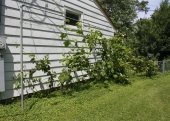
 2
2




 4
4




Invasive plants are Earth's way of insisting we notice her medicines. Stephen Herrod Buhner
Everyone learns what works by learning what doesn't work. Stephen Herrod Buhner
 2
2




-
 2
2




Nothing ruins a neighborhood like paved roads and water lines.
 2
2




 3
3




“We can complain because rose bushes have thorns, or rejoice because thorn bushes have roses.” — Abraham Lincoln
 3
3








Jen Fulkerson wrote:Hi Rachel, I experienced something very similar a few years ago. I had an area that was thick with weeds lots of Bermuda grass, that sounds similar to the grass your dealing with. I didn't have gardening in mind when I started. The weeds would get high, die, dry, and become a fire hazard in the summer. I didn't do the cardboard, the area was to big. It took at least 8", more like 12" of wood chips to suppress the weeds. It worked amazingly well. That year I had a bunch of extra seedlings, and thought why not make use of the space. I pulled the wood chips back in a cone shape, so the bottom connected with the soil,(which after a short time already seemed healthier) I filled it up with organic compost. It was the best melon crop I ever had. That's the good news. I won't say the bad news, but the challenge is the wood chips have to be replaced every year. I didn't do mine last year, and now I'm back to square one. I still think it's worth the work.
For my garden path I did put down cardboard, and 8" to 10" of wood chips. I didn't plant in the path. 2 years later I'm getting small patches of weeks.
For me it's totally worth the work. It suppressed the weeds, improved the soil, reduced water needs, and looks nice. It doesn't cost me anything but time, and work.
Good luck to you.




Douglas Alpenstock wrote:Phew, quackgrass. I know it well. It's a mighty tough opponent. If you keep after it you can control it, but you will never completely defeat it.
How big an area are we talking about?
Organic control is labour intensive. Tarping it for a season will weaken it. Loosening the soil is necessary to pull/dig out more of the roots and rhizomes.
Mature, well-established quackgrass seems to have both upper and lower root structures. So, the initial digs take a lot of work.
If it was a larger area, I would look into having a tractor and tine cultivator come in to initially break things up. A rototiller is less desirable, since broken off rhizomes turn into new plants; but it would still reduce the manual labour.
I find that it is much easier to pull roots and rhizomes early in spring. It seems all the tiny root hairs die off when it goes dormant. Once they grow back, they act like barbs in the soil and the rhizome will break off easily, compounding the problem.
FWIW, young quackgrass is good quality grazing fodder. Don't let it go to seed if possible, since the seeds are persistent for 5 years or so. I collect and rot/burn seed heads in fall.
I don't know if pigs might be an option?




“We can complain because rose bushes have thorns, or rejoice because thorn bushes have roses.” — Abraham Lincoln
 1
1




Henry Jabel wrote:I would tarp it until your sure its dead.
My tree nursery: https://mountaintimefarm.com/

|
What's that smell? Hey, sniff this tiny ad:
The new permaculture playing cards kickstarter is now live!
https://www.kickstarter.com/projects/paulwheaton/garden-cards
|






